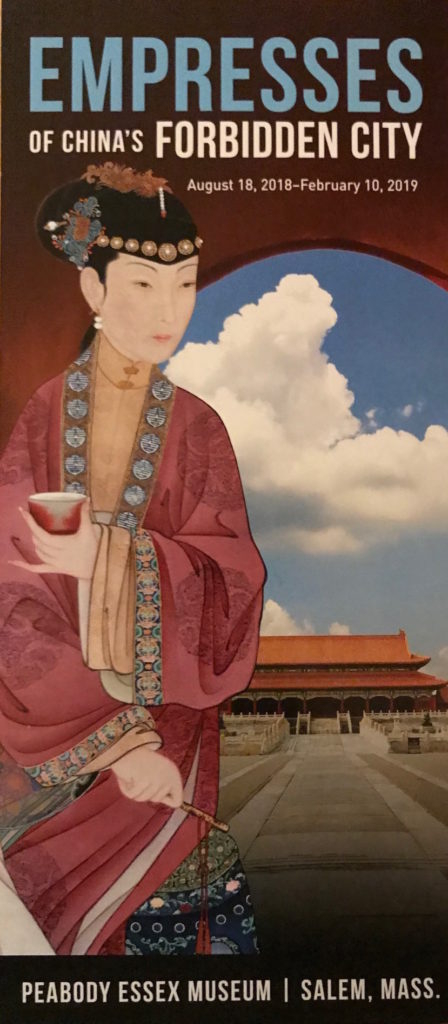Empresses of China’s Forbidden City is on view at the Peabody Essex Museum from August 18, 2018 to February 10, 2019
Halfway through the spectacular exhibition Empresses of China’s Forbidden City, 1644-1912 at the Peabody Essex Museum in Salem, MA, a tiny metal object sits in a transparent box next to a dressing case encrusted with precious stones. A roller is attached to a stick by a round handle, and both are coated in lustrous enamel with gilded finish. The label describes it as a massage tool, the kind that would improve circulation when pressed over one’s skin. Despite its minuscule size and evident utilitarian function, the tiny implement is crafted with the same punctilious, almost surgical precision and ornamental overabundance of the far grander objects that surround it. The Qing court was a saturated world of mirrored reflections, repetitions, and accumulated auspicious symbols that tied rulers to courtiers and people to things, architecture, and landscape (Fig. 1). Women, revered and paraded as moral exemplars, were integral to the mechanisms of courtly power, but, as the curators of this exhibition contend, their role was far less static and predictable than traditionally thought.
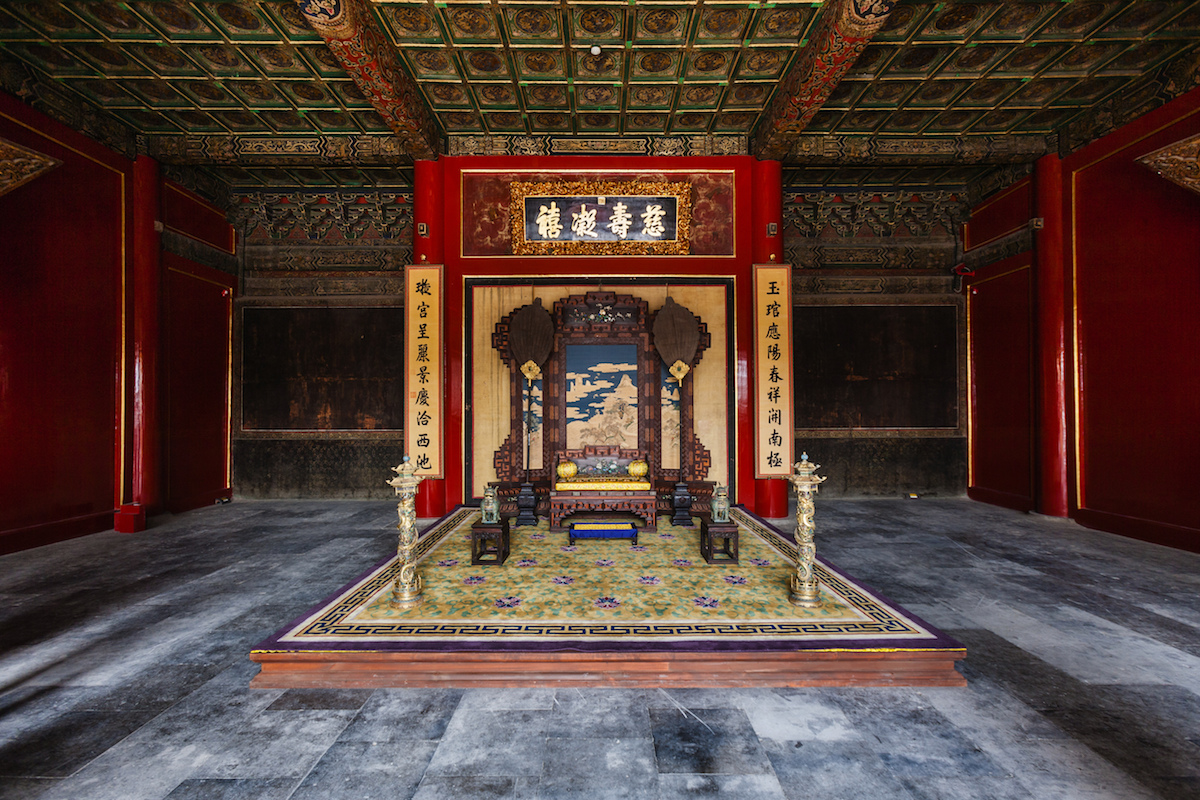
As the joint effort of Daisy Yiyou Wang of the Peabody Essex Museum and Jan Stuart of the Freer and Sackler Galleries, the exhibition showcases well-known objects from local North American collections alongside extraordinary loans from Beijing’s Palace Museum, some on view for the first time. It tells a familiar story from an unfamiliar angle: Qing emperors, at the pinnacle of a vast, cosmopolitan empire, realized the persuasive power of images and, with the support of highly specialized craftsmen, designed a synthetic imperial style that was more than the sum of its parts. Inner Asian, Mongol, Tibetan, Han, and even Western visual and material resources were wielded together to create a distinctive Qing imperial visuality that projected these ambitious emperors’ idea of universal rulership. Although the exhibition’s goal is to cover the entire two hundred fifty plus years of Qing dominion (1644-1912), two moments come under sharper focus: the ‘splendid age’ (shengshi) of the Kangxi-Yongzheng-Qianlong emperors (roughly 1660s-1790s), and the not-so-splendid late nineteenth century, when both court and empire fell under the leadership, and spell, of Empress Dowager Cixi (1835-1908).
The Peabody Essex show ends a ten-year hiatus following a spate of exhibitions on Qing court art that traveled around the world in the 2000s. Since then, our understanding of this period has not drastically changed but rather deepened, and the exhibition allows scholars and viewers to revisit some key ideas as well as to explore new facets of this extraordinary moment of artistic experimentation. The chronological split also highlights issues of artistic transmission and revival that were absent from the earlier exhibitions, which focused solely on the eighteenth century. Most importantly, it directs our attention to what was simply a footnote in all previous shows, that is, the role of women as agents in the Qing vision of command.
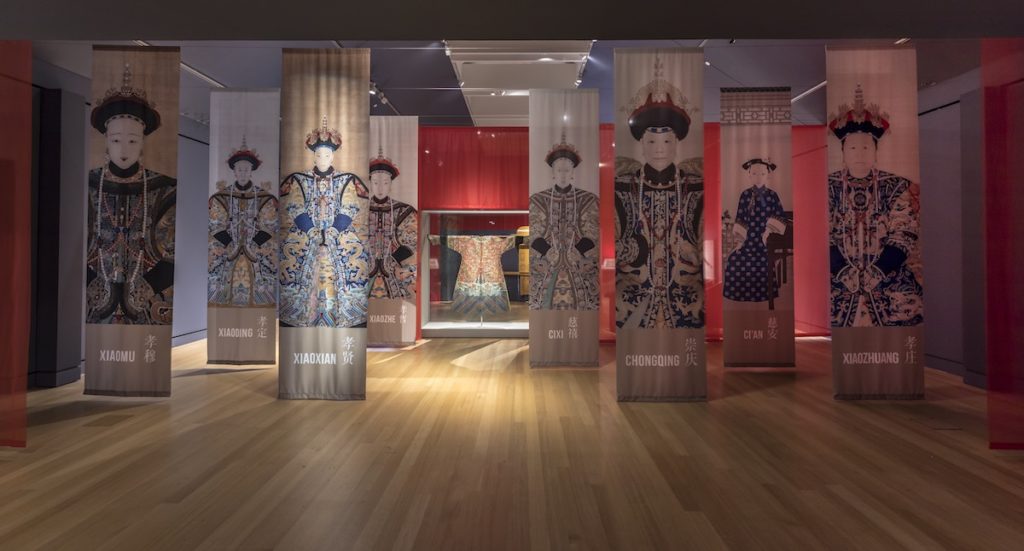
After a multimedia introduction to the main protagonists of the exhibition—two empresses and three empress dowagers—the exhibition follows key moments in the lives of these women: their wedding, arrival at court, training, daily activities, and involvement in the vibrant religious life of the time (Fig. 2). The last, large room at the Peabody is dedicated entirely to Cixi, and one finds here her well-known portraits next to less familiar paintings, calligraphy pieces, elaborate costumes, and accessories. The design of the exhibition uses a palette of bright primary colors, props and multimedia recreations to immerse the viewer into something not unlike the brimming, opulent interiors of Qing palaces and temporary residences. Short labels explain the meaning of omnipresent motifs like the lotus or the peach, while sound installations seek to bring texture to the solemn ceremonial portraits hanging throughout.
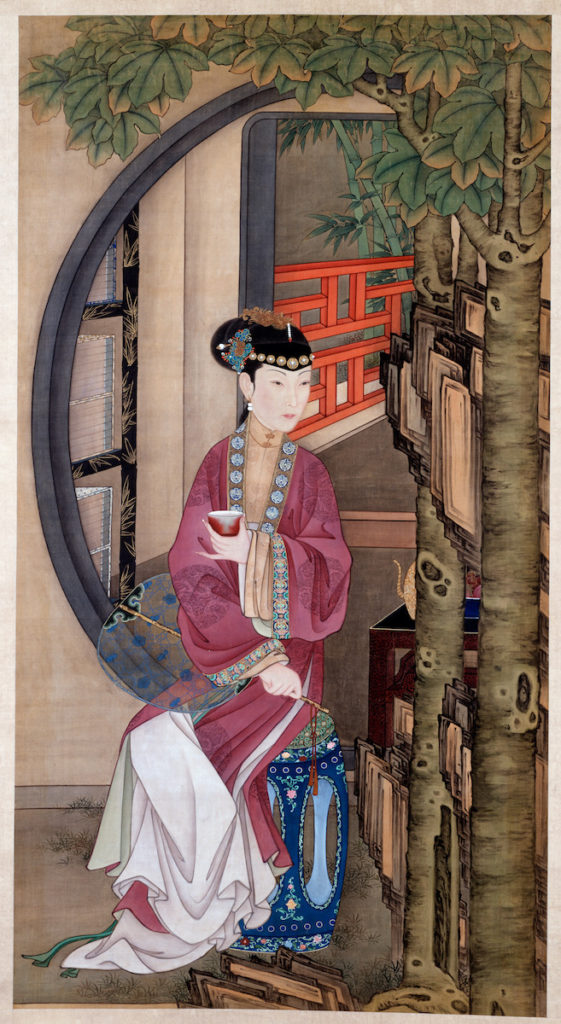
Who were these court women and how did they manage to carve out space for themselves amid the confining restrictions of court life? The exhibition concentrates on the highest ranks of the large population of consorts, ladies-in-waiting, maids, and shamans who lived in Qing imperial palaces. These elite women were the daughters of Mongol and Manchu noblemen (marriage with Han women was prohibited), who at the age of thirteen were carefully selected to join the imperial harem (Fig. 3). An emperor could have up to eight consorts, but only one was empress. In a large, striking album commemorating the wedding between the Emperor Guangxu (r. 1875-1908), Cixi’s nephew, to Xiaoding (1868), Cixi’s niece, a miniature sedan chair carrying the soon-to-be wife is brought by hundreds of officials to the gate of the gigantic palace that appears ready to ingurgitate her. Past that threshold, she would cut ties with her family, change her name to an honorific title, and take up a spot in the elaborate bureaucracy that organized these women’s everyday life, attire, allowance, residence, and relations. The most expedient way to improve one’s status was to bear a son. In Qing China, the male children of all consorts, not just those of the empress, could be selected as future emperor after a thorough evaluation of temperament. If a consort lived long enough, she could become Empress Dowager, the most influential role of all.
This was the case for Lady Niuhuru (1735-1777), beloved mother of the Qianlong Emperor (r. 1736-1795), who started as a low-ranking consort and was never empress, but who enjoyed decades of her son’s unwavering love as a severe Empress Dowager Chongqing. A tall bamboo cane on display in the exhibition carries a short poem by her son, the emperor, wishing her good health and inviting her to rely on it when he is not around. During her lifetime, temples were dedicated and palaces were built for Chongqing; after her death, a lock of her hair was deposited inside a monumental stupa made of gold, coral, and turquoise, also on view (Fig. 4). Filial love permeates the exhibition’s galleries, sometimes silencing the rivalry, jealousy, despair, and loss that tarnished these women’s interactions with one another and with their male companions. Unlike their female counterparts at other courts of the time, virtually nothing is known about these women’s own impressions and experiences of court life. We know they received some education, but no evidence of their involvement with writing has so far emerged from the archive. This is particularly surprising when we consider the dynamic literary and artistic life of elite women outside the court, but it is also a reminder that the Qing world, much like the rooms of its palaces, was an aggregate of cultural and social practices where multiple models of womanhood and femininity coexisted, with distinct expectations and opportunities.
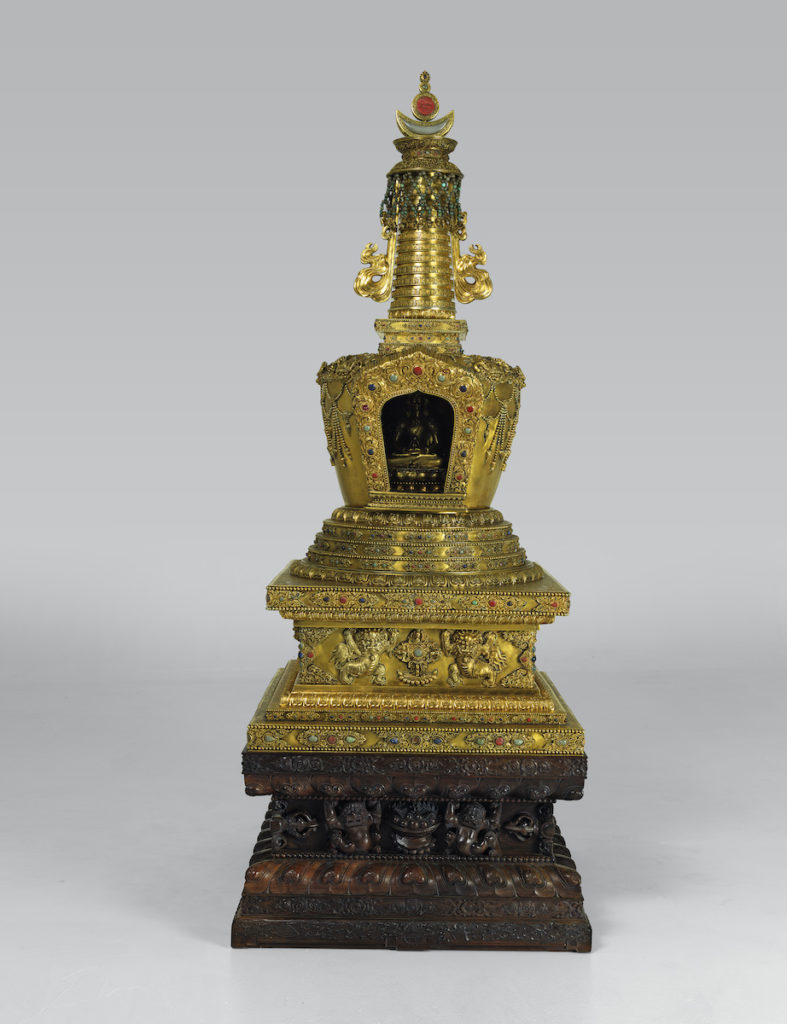
Official Qing documents and memorials say a lot about these women’s activities within and beyond the court, but when we turn to objects, the question gets more complicated. Most of what is in the show consists of things that were made and presented to women, not crafted or commissioned by them: including gifts offered at elaborate birthday celebrations, costumes and accessories to be worn on specific occasions, and things and furniture to decorate their residences, the refurbishing of which was also supervised by the emperor and his team. In the exhibition, it is difficult, if not impossible, to detect how taste evolved over time, not to mention individual preferences or inclinations. Courtly arts were rarely a space of self-assertion for men and even less so for women. Objects, paintings, and architecture situated women within a matrix of identities and roles that predated an individual woman’s arrival to court and eventually outlived her. No Madame de Pompadour or Hatice Sultan can be found in the exhibition’s galleries. Instead, individual identities merge together to create a remarkably cohesive image of the court woman that was painstakingly designed, like everything else, to persist over time and to cut across individual, interpersonal, and dynastic fluctuations. It suggests a kind of dispersed, unlocatable subjectivity that did not materialize into a distinct touch or gaze, but pervaded everything.
Yet this uniformity, this sense of projected continuity, does not necessarily imply a denial of agency, but rather a very particular realization of it. The strategic capacity of these women to inhabit preexisting iconographies, to assert their being beyond the constraints of material culture, to be part of the status quo more than of its dismantling, reveals much about the nexus of power and gender that lay at the core of court life. When dealing with the question of female agency, the show’s curators point to modes of gendered expression that are difficult to test against surviving material evidence. The complexity and uniqueness of this situation, in my opinion, calls for a new assessment of agency and gender, and I wish the contributors to the richly illustrated catalogue had pressed their analysis in this direction.
No one seems to have been more familiar with the intricacies of court life than Cixi, probably the most famous Qing palace lady then and now. When placed next to her predecessors, Cixi appears even more remarkable. Like many of them, she came to the palace as a low-ranking consort, but her life took an unexpected turn when she conceived a male child. From that moment on she masterminded the election of three child emperors to maintain control of the Inner Court, at moments serving as the empire’s de facto ruler. Aggressively opposed to the reforms that were required to keep the empire afloat in an increasingly competitive international arena, Cixi became the quintessence of Oriental despotism in Europe and of everything that had to be left behind among Qing progressive intellectuals. At court, Cixi strengthened her authority by appropriating symbols of power from the realms of high-ranking women and of men, especially her ideal model, the Qianlong Emperor. She set up a sort of shadow-court of female confidantes, promoted women artists, and, like Qianlong, painted, wrote calligraphy, sponsored theatrical performances, redecorated palaces, and built new ones. There is something haunting in the contrast between the dilapidated imperial buildings, worn out by neglect and repeated sacking, in historical photographs and their formerly jam-packed, magniloquent décor. Cixi skillfully navigated Qing iconographies and courtly rituals without breaking them, without subverting them to the creation of something radically new.
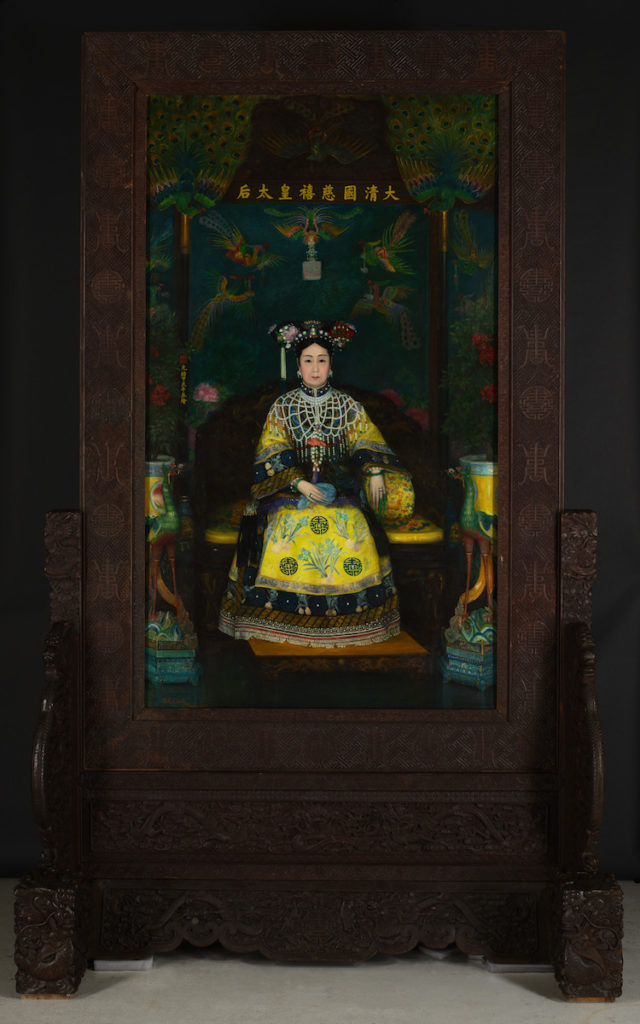
However, the realm that was most deeply affected by Cixi’s intervention was her image. Cixi realized that a powerful ruler needed a powerful image that could circulate outside the palace—something that no prior Qing ruler had ever had. The exhibition chronicles Cixi’s project of forging a new imperial image in paintings and in the newly available medium of photography. In some instances, Cixi’s posturing is so self-assertive that the Empress Dowager resembles an actress on stage; in others, such as a monumental oil portrait by the American painter Katharine Carl, her minuscule shape dissolves behind the symbols of power assembled to support her (Fig. 5). This last picture, a canvas encased in a dark, wooden screen, was created for the 1904 Louisiana Purchase Exposition. It was shipped to Saint Louis in a big case wrapped in imperial fabric that resembled an overblown bridal sedan chair. A New York Times reporter commented at the time on the painting’s size as inappropriate for the depiction of a woman. When the gates of the imperial harem opened to the general public, a new form of prudishness replaced the old one.
Empresses of China’s Forbidden City will open again at the Freer and Sackler Galleries in Washington, DC at the end of March
Michele Matteini is Assistant Professor of East Asian Art at New York University
Cite this note as: Michele Matteini, “Empresses of China’s Forbidden City, 1644-1912: A Review,” Journal18 (January 2019), https://www.journal18.org/3357.
Licence: CC BY-NC
Journal18 is published under a Creative Commons CC BY-NC International 4.0 license. Use of any content published in Journal18 must be for non-commercial purposes and appropriate credit must be given to the author of the content. Details for appropriate citation appear above.

